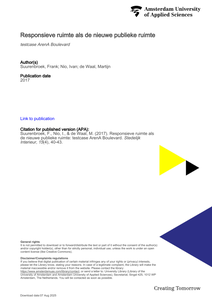De oplossing voor vraagstukken in de publieke ruimte wordt doorgaans in fysieke maatregelen gezocht. Dat is een kostbare aangelegenheid. Er zijn nu ook nieuwe middelen om de publieke ruimte te versterken. Frank Suurenbroek, Ivan Nio en Martijn de Waal van de Hogeschool van Amsterdam (HvA) onderzoeken hoe interactieve objecten de openbare ruimte aangenamer kunnen maken voor de gebruiker. De ArenA Boulevard vormt hiervoor de proeftuin.
DOCUMENT

Responsive public spaces use interactive technologies to adapt to users and situations. This enhances the quality of the space as a public realm. However, the application of responsive technologies in spatial design is still to be explored. What exactly are the options for incorporating responsive technologies in spatial designs to improve the quality of public spaces? The book Responsive Public Spaces explores and disentangles this new assignment for designers, and presents inspiring examples. A consortium of spatial designers, interaction designers and local stakeholders, headed by the Chair of Spatial Urban Transformation of Amsterdam University of Applied Sciences, carried out a two-year practice-based study of responsive public spaces. This book draws on those insights to provide a practical approach and a roadmap for the new design process for responsive public spaces.The study results are of signi¬icance for various professional fields. The book is intended for clients and stakeholders involved in planning and design of public spaces, spatial designers, interaction designers and students.
DOCUMENT

Hoe kan de verblijfskwaliteit en veiligheidsperceptie van de publieke ruimte versterkt worden door de toepassing van “interactieve objecten”? (objecten die met beeld, licht, geluid en sensoren real time reageren op de gebruikers en de ruimte daarop afstemmen). De ontwikkeling van deze zogenaamde responsieve ruimte staat nog in de kinderschoenen maar is beloftevol vanwege de meerwaarde voor de leefbaarheid en het onderscheidend vermogen van de plek en de bedrijven. In Co-ReUs worden drie verschillende mkb groepen samengebracht: stedenbouwbureaus, creatieve conceptontwikkelaars en lokale ondernemers. We gebruiken de ArenA-Boulevard als proeftuin: een als ongezellig ervaren ruimte (lage verblijfskwaliteit en slechte veiligheidsperceptie). De mkb-ers lossen hiermee hun eigen praktijkproblemen op: Stedenbouwbureaus houden zich bezig met het ontwerp van de publieke ruimte. Zij merken dat hun instrumentarium (herontwerp, herbestrating etc.) te kapitaalintensief en te weinig flexibel is om de verblijfskwaliteit en veiligheidsperceptie op dit soort plekken op te lossen. De bureaus hebben behoefte aan een lichter, gerichter en responsiever instrumentarium. Ze hebben echter beperkte (technologische) kennis hoe interactieve objecten precies een bijdrage kunnen leveren. Creatieve conceptontwikkelaars hebben een ander probleem: zij hebben wél de beschikking over interactieve objecten (geluid, beeld, licht, sensoren) maar die zijn vooral kunstzinnig en evenementiëel. De objecten zijn stuk voor stuk niet ontwikkeld vanuit een stedenbouwkundige opgave waardoor ze hiervoor geen panklare oplossing vormen. Lokale mkb-ers hebben ook een probleem: zij weten niet goed hoe zij op een gecoördineerde manier invloed kunnen uitoefenen op de activering van de publieke ruimte. Project Co-ReUs: 1) analyseert hoe de ruimte wordt gebruikt (nulmeting en Programma van Eisen voor de inzet van interactieve objecten; 2) ontwikkelt ruimtelijk-interactieve interventies in co-creatie met de drie mkb groepen. 3) deze worden op het plein geplaatst en nametingen brengen de effecten in beeld. Het resultaat is een actiegerichte Handleiding met Roadmap voor de ontwikkeling van responsieve publieke ruimtes.